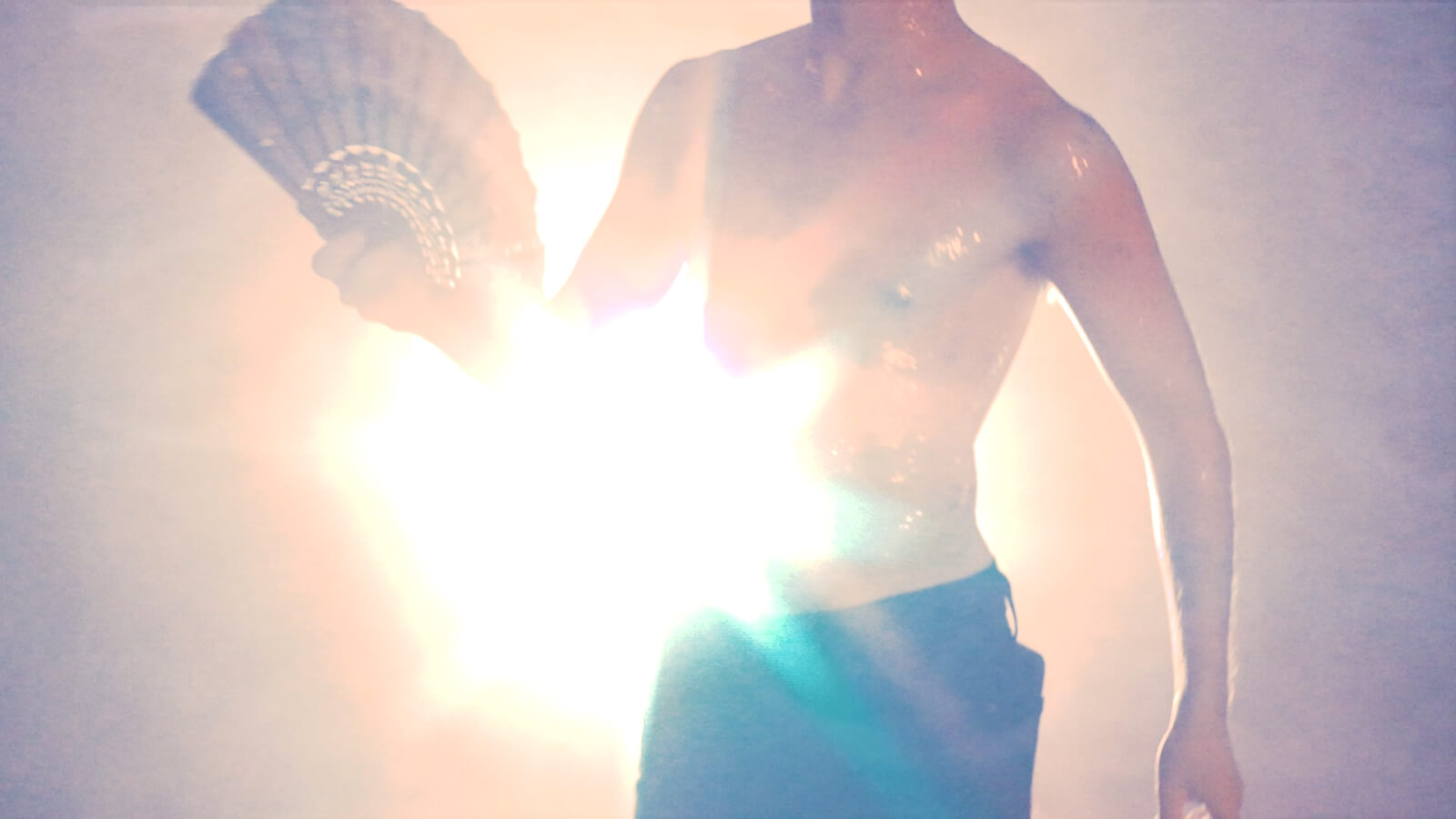
We’re not pretending hard enough: an interview with Daniel Moldoveanu
For the reopening of SABOT in Cluj-Napoca, Romania, the artists becomes a poet, a nihilist, and finally, an accelerationist.
Top image: Daniel Moldoveanu, Flickering (2020), video still
Portrait: Daniel Moldoveanu, 2022 by Luke Abby

Daniel Moldoveanu’s Flickering (2020), showing at SABOT in Cluj-Napoca, Romania, focuses on the feel, wear, and taste of the mundane to evade the telling of a story. Instead, “The Whatever Moment” surfaces video stills UV-printed onto painted canvases, unearthing the reliving of flickering moments as iconography. Today — where fewer authorities gaud over the validity of art, culture, and reality — we find ourselves not at a critical impasse but completely resigned. There are less choices to make, less certainty in the risks one takes, and art reflects this utter loss. In response we choose not to build, but to create; create capital, create clout, create copies of creations. The validation of our human experience exists as a set of stills, frames, and images solicited to us as creations designed as vehicles for consumption.
The potency of meme-culture and TikTok cinephilia confirm this and pose the question: do we all live in variations of the same type of life? It’s almost like no thought or happening is sacred enough, expected enough, or sedated enough to be exempt from becoming a stock-image. To be unique is to not relate, and when one cannot relate, impressions become brief, if existent at all. In this sense, the title of Daniel’s show holds true to its prescription: a life rendered into moments that become over-relatable is completely “whatever.”
Reva-Ifeoma Ochuba: In their essay dedicated to your video piece Flickering (2020), Ulysse Carrière-Bouchard writes: “It is when inconsequentiality becomes inconsequential that language is lost.” How do you interpret their statement in relation to your work?
D: I’ve come to the conclusion that, at some point in human history, maybe before I was even born, every single thing stopped holding true meaning or true consequence. As a teenager, I was lamenting this loss. I wanted everything to be “profound.” Now I’m like: this is lit. Meaninglessness and inconsequentiality can afford you more freedom. Superficiality hides depth in that it can be used as a tool to embellish your life with more spontaneity and creativity. Roland Barthes said language is fascist, I agree. Bye, bye language.
R: Don’t you publish essays?
D: Yeah, but I don't see a contradiction. Essays are spontaneous, almost performative, unaccountable acts of creative writing. If anybody would come to me in a debate and try to negate my arguments citing some essay I wrote, I would simply say “that was then, and this is now.”
R: We were talking about how Ervin Goffmann’s The Presentation of Self in Everyday Life informed your exhibition, specifically the scenery of your video. In your own essay, you underline that most frames take place in institutional settings (hospital, gym, school etc.), places with didactic utility. Are they mundane by default? Does desire play a role?
D: Mundanity is a feeling; we feel things to be mundane. This happens when the repetitive character of everyday life leads to an experience so systematized by its very nature that you could, as an active performer, navigate it with your eyes closed. Girard’s concept of “mimetic desire” is fundamental to the importance of repetition in capitalist thinking; in optimizing production to fit ever-systematic demands, downsizing risk. Mimetic desire leads to imitation, which leads to repetition, which constitutes a routine. If Flickering makes the argument that mundane situations (making up the majority of lived experience by definition) have become so performative and lacking of depth that each individual life resembles stock-imagery, then it also begs the question to which extent this is really a nihilistic/dystopian condition. Isn’t it kind of soothing that way?
R: The aesthetics of Sam Levinson’s Euphoria (2019) inspired the dancing scene in your film. Why?
D: Because I love everything Gen-Z-related. Best generation yet. Every character in that show is the protagonist of their own narrative, but they’re not assholes about it. I wanted this to be the only poetic sequence with a somewhat hypnotizing character, a kind of innocent narcissism. While other frames make performativity evident by alienation, this one celebrates performativity as introspection. It’s more abstract and anonymous, like a place to visually come back to.
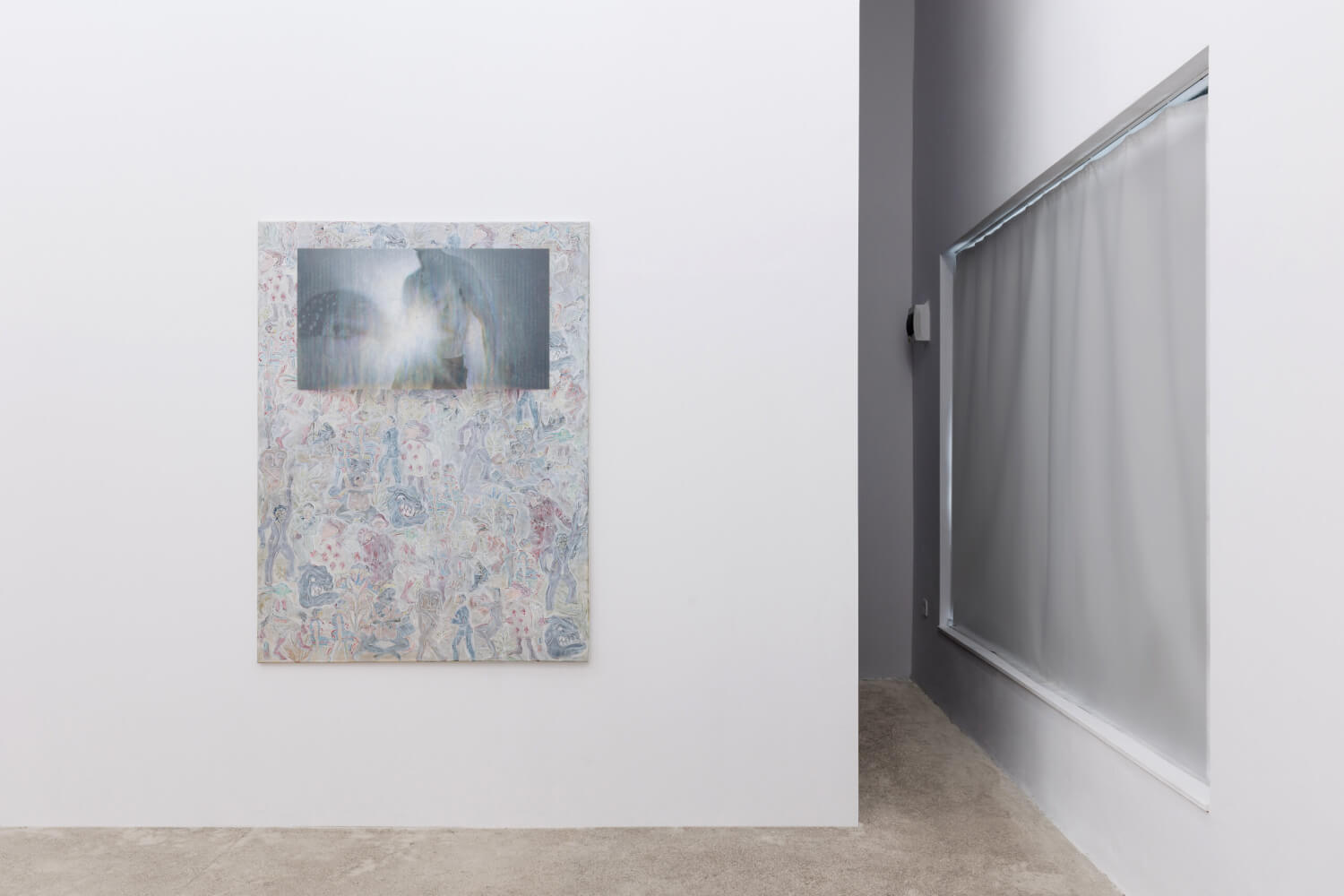
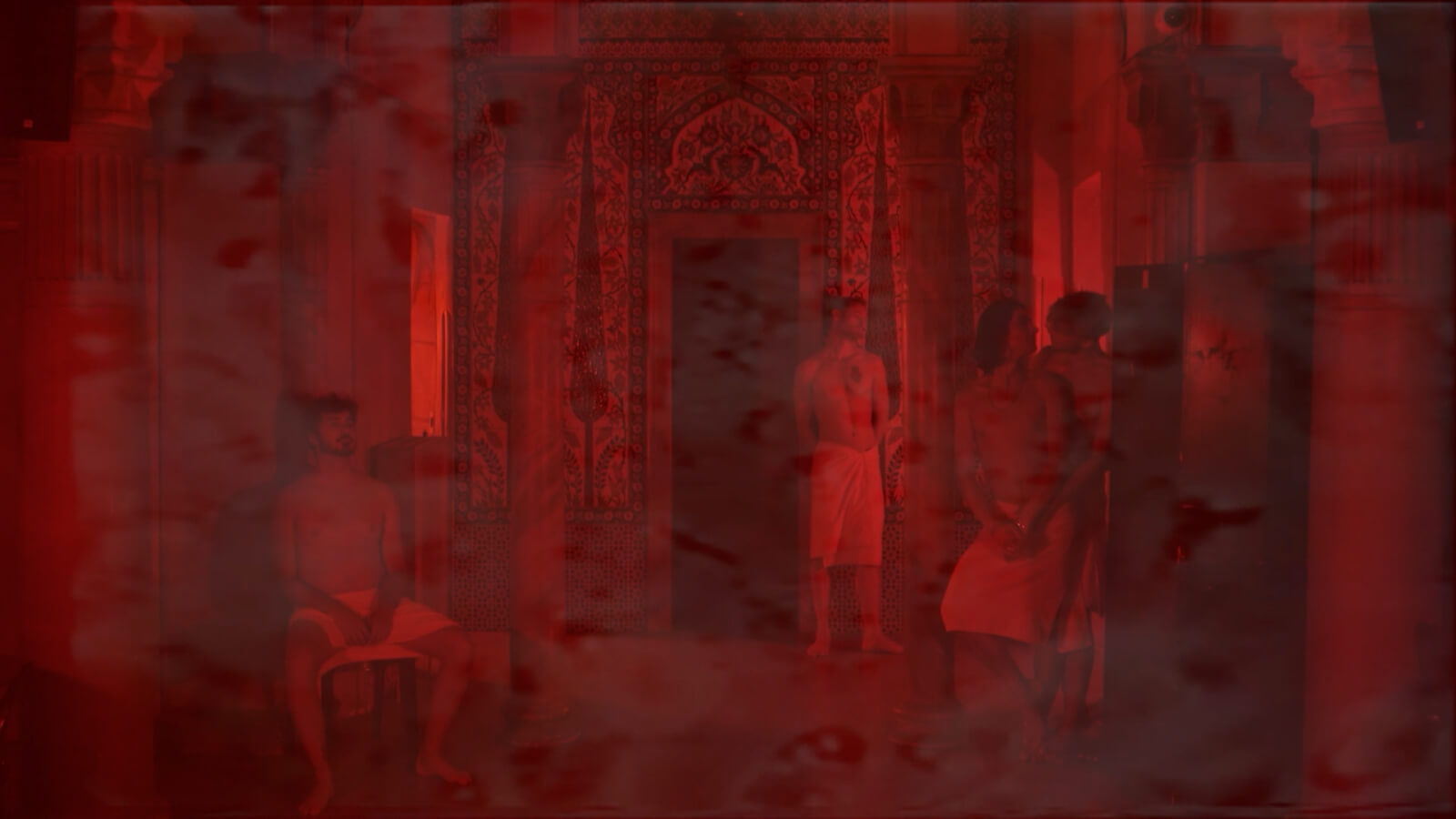
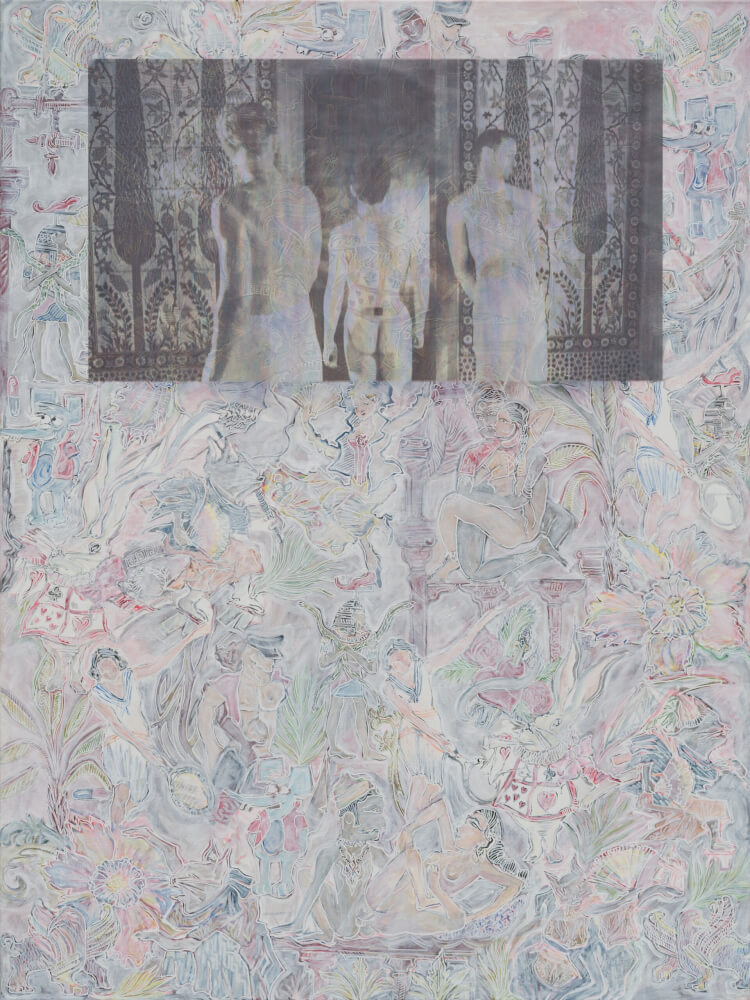
Top image: Daniel Moldoveanu, The Whatever Moment, installation view.
Photo: YAP Studio / Mădălin Mărgăritescu
Bottom images: Daniel Moldoveanu, Flickering (2020), video still,
Daniel Moldoveanu, Image 2, Scene 2 (2020). Acrylic, correction pen, white marker, UV-Print on canvas. 120 x 160 cm Photo credit: YAP Studio / Pavel Curagău
R: You mentioned narcissism. Is this an exhibition about yourself?
D: It’s an exhibition about life today, and the only life I felt I could seriously make observations on was my own.
R: We often relegate the impoverishment (material or ontological) of mass-culture to the concept of a working class, which is also akin to mundanity. Do you agree?
D: Historically, this was true. Right now, luxury in terms of material goods is hard to pinpoint, as even the most “exclusive” of products: opulent architecture, machines, vehicles, even art, are in reality produced serially, if not en-masse; a smaller mass perhaps, but nonetheless.
Mundanity stretches through all social classes. To transgress it, you should be either radically poor or radically rich. When you’re in the middle, it’s a pain. You hold no real stakes in the system yet possess just enough to make yourself dependent on power structures most people intrinsically dislike.
R: How would you say capitalism informs our auto-pilot sense to relegate everything into boxes and norms?
D: The production-consumption cycle requires a stable environment, that’s where it starts. Things get put into norms and boxes in order for them to make sense. You cannot constantly second-guess and re-imagine the very ground you stand on, if you wish to continue walking. You need to decide on an “image” of the ground and stick to it. To create cohesion, you need to cling onto images that don’t change. Cohesion is choosing to ignore certain aspects in favor of others, for the sake of stability.
R: So, capitalism is cohesive?
D: It wishes it were. The problem is there is such a surplus of everything, including immaterial things like narratives, references, medial associations, etc., that we end up walking around with dozens of mental images of the same ground. That’s when things turn trippy. Especially because all these different images are legitimate and correct, yet different in themselves, co-existing at the same time in our heads.
R: One painting in the exhibition centers around a famous Tarot card, “The Fool'', depicting a man obviously walking off a cliff. Is that a testament to your own desire for quasi naivety, or a different collective criterion?
D: Tarot cards look to me like illustrations from a fairytale children's book. Yet, for so many people, they are vessels of meaning and consequence. It’s this dynamic, between seemingly naive aesthetics and earnest reception that makes them feel so parallel to lived experience.
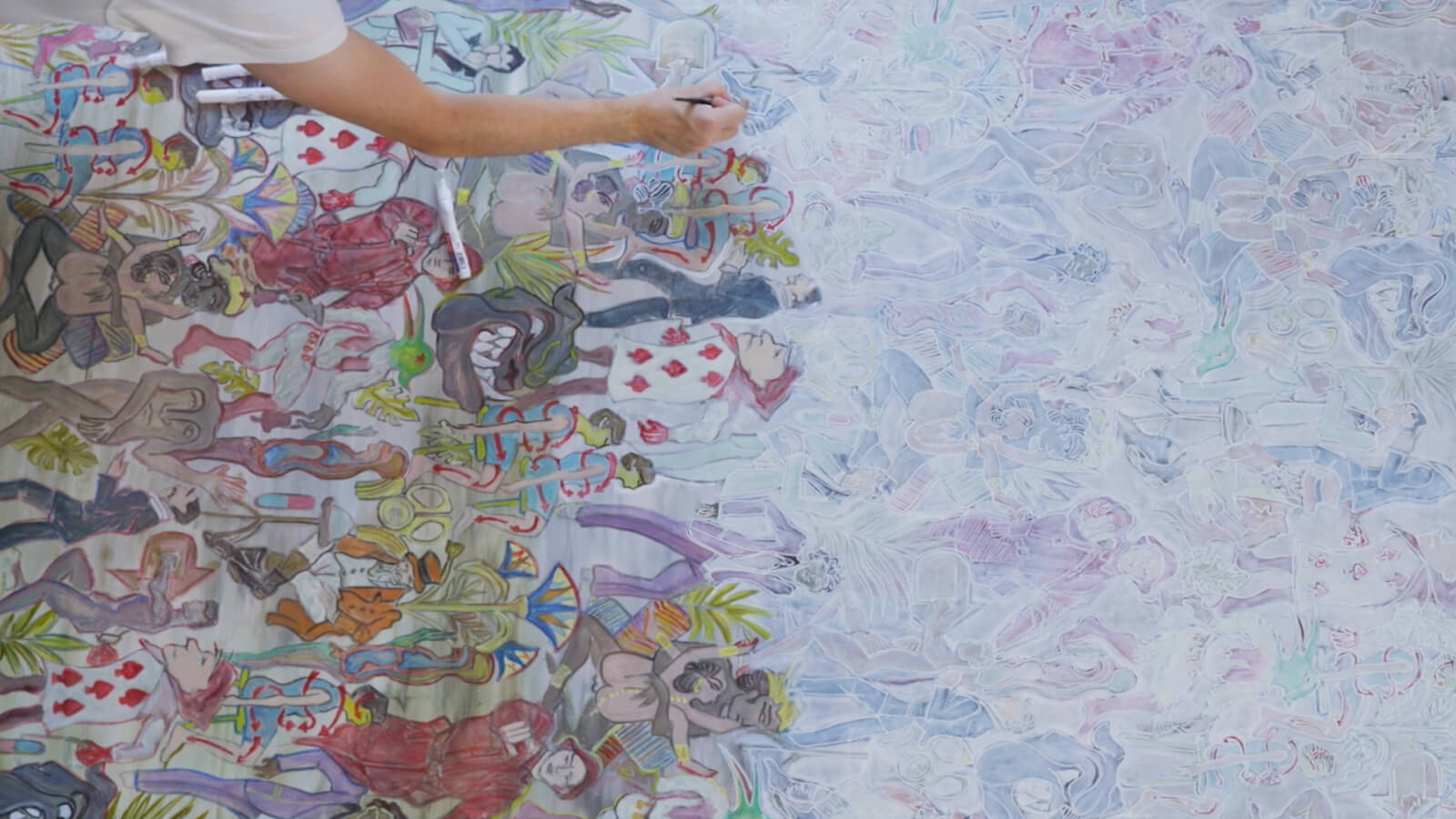
Daniel Moldoveanu, Flickering (2020), video still
R: Why “The Fool” and not any other card?
D: Primarily aesthetic reasons. When I plan the compositions, I usually do visual research that centers around a fundamental criteria: two dimensional figuration. The combination of different motifs in creating these tapestry-like surfaces is less about the connotations and symbolism they carry inherently (ie. their individual meaning, origin, style, subject-matter), and more about meshing significantly different elements into something that, on first glance, gives off the impression of homogeneity.
R: That’s also superficial, then.
D: One hundred percent. I feel like, what I really try to do is create things that allude to some kind of meaning but are really just layers of superficiality stacked on top of more superficiality.
People become nihilistic because the world seems increasingly fake and deceiving, confusing, make-pretend. I see myself as an accelerationist in that regard. We’re not pretending hard enough.
Interview: Reva-Ifeoma Ochuba

We’re not pretending hard enough: an interview with Daniel Moldoveanu
For the reopening of SABOT in Cluj-Napoca, Romania, the artists becomes a poet, a nihilist, and finally, an accelerationist.
Top image: Daniel Moldoveanu, Flickering (2020), video still
Portrait: Daniel Moldoveanu, 2022 by Luke Abby

Daniel Moldoveanu’s Flickering (2020), showing at SABOT in Cluj-Napoca, Romania, focuses on the feel, wear, and taste of the mundane to evade the telling of a story. Instead, “The Whatever Moment” surfaces video stills UV-printed onto painted canvases, unearthing the reliving of flickering moments as iconography. Today — where fewer authorities gaud over the validity of art, culture, and reality — we find ourselves not at a critical impasse but completely resigned. There are less choices to make, less certainty in the risks one takes, and art reflects this utter loss. In response we choose not to build, but to create; create capital, create clout, create copies of creations. The validation of our human experience exists as a set of stills, frames, and images solicited to us as creations designed as vehicles for consumption.
The potency of meme-culture and TikTok cinephilia confirm this and pose the question: do we all live in variations of the same type of life? It’s almost like no thought or happening is sacred enough, expected enough, or sedated enough to be exempt from becoming a stock-image. To be unique is to not relate, and when one cannot relate, impressions become brief, if existent at all. In this sense, the title of Daniel’s show holds true to its prescription: a life rendered into moments that become over-relatable is completely “whatever.”
Reva-Ifeoma Ochuba: In their essay dedicated to your video piece Flickering (2020), Ulysse Carrière-Bouchard writes: “It is when inconsequentiality becomes inconsequential that language is lost.” How do you interpret their statement in relation to your work?
D: I’ve come to the conclusion that, at some point in human history, maybe before I was even born, every single thing stopped holding true meaning or true consequence. As a teenager, I was lamenting this loss. I wanted everything to be “profound.” Now I’m like: this is lit. Meaninglessness and inconsequentiality can afford you more freedom. Superficiality hides depth in that it can be used as a tool to embellish your life with more spontaneity and creativity. Roland Barthes said language is fascist, I agree. Bye, bye language.
R: Don’t you publish essays?
D: Yeah, but I don't see a contradiction. Essays are spontaneous, almost performative, unaccountable acts of creative writing. If anybody would come to me in a debate and try to negate my arguments citing some essay I wrote, I would simply say “that was then, and this is now.”
R: We were talking about how Ervin Goffmann’s The Presentation of Self in Everyday Life informed your exhibition, specifically the scenery of your video. In your own essay, you underline that most frames take place in institutional settings (hospital, gym, school etc.), places with didactic utility. Are they mundane by default? Does desire play a role?
D: Mundanity is a feeling; we feel things to be mundane. This happens when the repetitive character of everyday life leads to an experience so systematized by its very nature that you could, as an active performer, navigate it with your eyes closed. Girard’s concept of “mimetic desire” is fundamental to the importance of repetition in capitalist thinking; in optimizing production to fit ever-systematic demands, downsizing risk. Mimetic desire leads to imitation, which leads to repetition, which constitutes a routine. If Flickering makes the argument that mundane situations (making up the majority of lived experience by definition) have become so performative and lacking of depth that each individual life resembles stock-imagery, then it also begs the question to which extent this is really a nihilistic/dystopian condition. Isn’t it kind of soothing that way?
R: The aesthetics of Sam Levinson’s Euphoria (2019) inspired the dancing scene in your film. Why?
D: Because I love everything Gen-Z-related. Best generation yet. Every character in that show is the protagonist of their own narrative, but they’re not assholes about it. I wanted this to be the only poetic sequence with a somewhat hypnotizing character, a kind of innocent narcissism. While other frames make performativity evident by alienation, this one celebrates performativity as introspection. It’s more abstract and anonymous, like a place to visually come back to.



Top image: Daniel Moldoveanu, The Whatever Moment, installation view.
Photo: YAP Studio / Mădălin Mărgăritescu
Bottom images: Daniel Moldoveanu, Flickering (2020), video still,
Daniel Moldoveanu, Image 2, Scene 2 (2020). Acrylic, correction pen, white marker, UV-Print on canvas. 120 x 160 cm Photo credit: YAP Studio / Pavel Curagău
R: You mentioned narcissism. Is this an exhibition about yourself?
D: It’s an exhibition about life today, and the only life I felt I could seriously make observations on was my own.
R: We often relegate the impoverishment (material or ontological) of mass-culture to the concept of a working class, which is also akin to mundanity. Do you agree?
D: Historically, this was true. Right now, luxury in terms of material goods is hard to pinpoint, as even the most “exclusive” of products: opulent architecture, machines, vehicles, even art, are in reality produced serially, if not en-masse; a smaller mass perhaps, but nonetheless.
Mundanity stretches through all social classes. To transgress it, you should be either radically poor or radically rich. When you’re in the middle, it’s a pain. You hold no real stakes in the system yet possess just enough to make yourself dependent on power structures most people intrinsically dislike.
R: How would you say capitalism informs our auto-pilot sense to relegate everything into boxes and norms?
D: The production-consumption cycle requires a stable environment, that’s where it starts. Things get put into norms and boxes in order for them to make sense. You cannot constantly second-guess and re-imagine the very ground you stand on, if you wish to continue walking. You need to decide on an “image” of the ground and stick to it. To create cohesion, you need to cling onto images that don’t change. Cohesion is choosing to ignore certain aspects in favor of others, for the sake of stability.
R: So, capitalism is cohesive?
D: It wishes it were. The problem is there is such a surplus of everything, including immaterial things like narratives, references, medial associations, etc., that we end up walking around with dozens of mental images of the same ground. That’s when things turn trippy. Especially because all these different images are legitimate and correct, yet different in themselves, co-existing at the same time in our heads.
R: One painting in the exhibition centers around a famous Tarot card, “The Fool'', depicting a man obviously walking off a cliff. Is that a testament to your own desire for quasi naivety, or a different collective criterion?
D: Tarot cards look to me like illustrations from a fairytale children's book. Yet, for so many people, they are vessels of meaning and consequence. It’s this dynamic, between seemingly naive aesthetics and earnest reception that makes them feel so parallel to lived experience.

Daniel Moldoveanu, Flickering (2020), video still
R: Why “The Fool” and not any other card?
D: Primarily aesthetic reasons. When I plan the compositions, I usually do visual research that centers around a fundamental criteria: two dimensional figuration. The combination of different motifs in creating these tapestry-like surfaces is less about the connotations and symbolism they carry inherently (ie. their individual meaning, origin, style, subject-matter), and more about meshing significantly different elements into something that, on first glance, gives off the impression of homogeneity.
R: That’s also superficial, then.
D: One hundred percent. I feel like, what I really try to do is create things that allude to some kind of meaning but are really just layers of superficiality stacked on top of more superficiality.
People become nihilistic because the world seems increasingly fake and deceiving, confusing, make-pretend. I see myself as an accelerationist in that regard. We’re not pretending hard enough.
Interview: Reva-Ifeoma Ochuba

